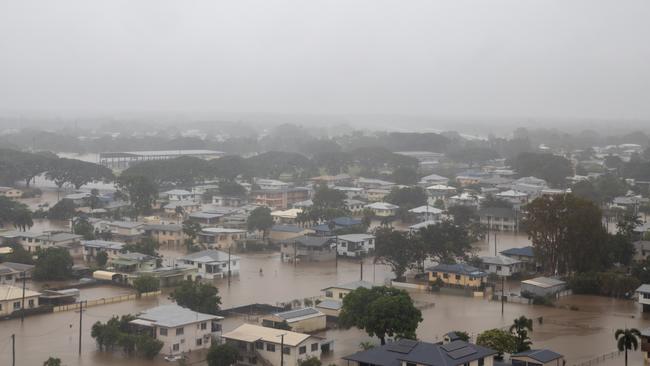Qld floods: Worst zones revealed amid $30bn future-proofing scheme
Building flood levees, strengthening homes and even relocating residents are among the recommendations of a $30bn future flood strategy.

QLD weather news
Don't miss out on the headlines from QLD weather news. Followed categories will be added to My News.
A $30bn warchest to build new flood levees, strengthen and lift homes or relocate residents entirely is needed to drive down insurance premiums and protect those in the most at-risk river catchments.
The key recommendation by the Insurance Council of Australia is one of the measures published on Wednesday in Advancing Australia’s Resilience, a policy document it wants endorsed by the next federal government.
Australia experienced its quietest six months in a six-year period for insurance claims in the lead-up to January, before North Queensland was lashed by flooding rains.
Now as Queensland anxiously follows the path of Tropical Cyclone Alfred, the ICA is calling for a comprehensive range of initiatives to protect those living in 11 river catchments most at risk of flooding, based on population and potential assets lost.
It also comes on the third anniversary this week of the 2022 floods, which costs 23 lives and saw insured losses of almost $6.4bn.
The ICA’s proposal is centred on a $30.15bn investment over 10 years in a Flood Defence Fund.
The proposed fund would split the significant cost between the federal government and the state governments of New South Wales, Queensland, and Victoria, which are the jurisdictions with the most high and extreme flood-exposed properties.
It would deliver new critical flood defence infrastructure like new levees ($15bn), strengthen properties in harm’s way by lifting or better waterproofing ($5bn), help local governments with buybacks ($10bn) and future-proof existing flood mitigation infrastructure ($150m).
“Flood is having the biggest impact on insurance premiums everywhere because that cost does get spread across everybody, not just those in flood zones,” Insurance Council CEO Andrew Hall said.
“Insurance is designed to protect you against if the unexpected happens.
“The problem with a flood is that it’s expected to happen, we actually have got all the data and knowledge now to understand the chances of it happening every year … and what it will cost to fix it all up.”
Another recommendation to help oversee the challenges of managing risk and recovery is the appointment of a new federal minister for flood defence.
“We think Australia has got a very big challenge on its hands, and we’ve got to start thinking about infrastructure for flood defence the same way we’ve thought about roads and rail,” he said.
“Ultimately, the taxpayer at the Commonwealth level is the one who’s picking up the bill when disasters go over a certain scale, and those risk factors are impacting the cost and operation insurance that all sits in a different portfolio,
“We actually need somebody who can bring it together.”
Mr Hall said while mitigation and risk reduction programs were needed long term, immediate action on tax and regulatory reform was also essential so people who pay premiums aren’t punished.
“Around 20 per cent of your premium in Queensland is stamp duty and GST,” he said.
“We think that the time has come for the community to be really aware of the amount of tax they are paying through their insurance premiums, and we would question whether that is a modern way of raising revenue.”
Advancing Australia’s Resilience also outlines the need for better data and flood mapping, improving disaster response and funding arrangements, better land use planning, lowering risks for small businesses and not-for-profits and enhancing cyber security.

HIGH-RISK CATCHMENTS
QUEENSLAND
Brisbane River
Burnett River
Condamine-Culgoa rivers
Fitzroy River
Logan-Albert rivers
Maroochy River
Mulgrave-Russell rivers
Pine River
Pioneer River
Ross River
South Coast
NEW SOUTH WALES
Clarence River
Hawkesbury River
Hunter River
Macquarie-Tuggerah Lakes
Murray Riverina
Murrumbidgee River
Namoi River
Richmond River
Sydney Coast-George River
Tweet River
Wollongong Coast
VICTORIA
Goulburn River
Yarra River





